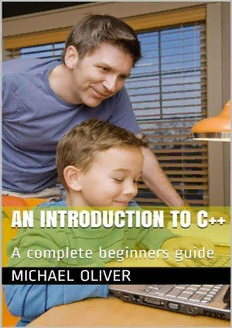
An Introduction to C++: A Complete Beginners Guide PDF
Preview An Introduction to C++: A Complete Beginners Guide
C++ Programming Essentials Key Words break case char default do double else float for goto if int long operator signed static switch unsigned void while Data Types char A single character int An integer is a whole number float A floating point number, correct to six decimal places double A floating point number, correct to ten decimal places bool A Boolean value of true (1) or false (0) string A group of characters Library Classes <iostream> Reads and writes to the console <iomanip> Manipulates input and output <fstream> Reads and writes to a text file <string> Stores and manipulates text streams <sstream> Converts strings to other data types <vector> Stores and manipulates data in vector array elements <stdexcept> Reports logic errors and runtime errors <ctime> Reports date and time Introduction to C++ Creating your first C++ project in Visual studio 2013 Understanding your 1 C++ Program st Solving Errors in C++ Annotating Your Code Adding Multiple Line of Code Introduction to Variables Using Integers and Characters in C++ Using floats in C++ Using strings Getting User Input Variable Arithmetic Global and local variables Intro conditional statements Logical Operators and Conditional statements Creating a calculator using conditional statements Nesting If/Else statements Introduction to Switch Statements Nesting switch/case statements Introduction to Loops While loops Do… While Loops For Loops Introduction to Functions Introduction to Arrays Extension Activities The ASCII Table ASCII Table (Binary values 31-127) Glossary Further Reading Introduction to C++ C++ was developed by Bjarne Stroustrup of AT&T Bell Laboratories in the early 1980’s, and is based on the C language. The name is a pun - “++” is a syntactic construct used in C (to increment a variable), and C++ is intended as an incremental improvement of C. Most of C is a subset of C++, so that most C programs can be compiled (i.e. converted into a series of low-level instructions that the computer can execute directly) using a C++ compiler. C++ is considered to be a multi paradigm language, as the way it can be implemented can vary. This book will cover C++ as a procedural language, and conforms to the ANSI (American national standard institute) and ISO (International standards organisations). This means that you can take all the source code from this book, and run it in any compiler. To be able to successfully run the source code in this book you will need the following: A computer (Windows, OSx, Linux) An IDE (Integrated development environment) Windows (Visual Studio) OSx (X code) Linux (Code Blocks) For a free version of this software, then please visit www.bcotcomputing.co.uk All source code in this guide has been implemented using Visual Studio 2013 professional and can be found on the school’s website. This software has been installed on all of the machines in the school of computer of science. It can also be downloaded for free using your dreams spark account by clicking this link Creating your first C++ project in Visual studio 2013 This guide has been created to show how to setup, create and compile your first C++ program “Hello world”. Before you begin to code your program, you will need to load up an IDE (Integrated development environment) To do this click the start icon , and type visual. You should see the following: Click “Visual Studio 2013” and the Visual Studio loading screen will appear on your desktop: After the loading screen, the Visual Studio start page should load. In this screen you can create new projects, open existing projects or even access guidance and resources. To create a new project we need to click “new project”. Once you click on new project, you will be presented with a new window (See below) in the left hand pane you will a series of programming languages. By default visual C++ will be displayed as the main language. Under visual C++ you will see an option “win32”, click this option to be presented with “win32 console application”. Click this and give your project the name of “hello world” Once you have named the project, click next and you will be presented with a win32 Application wizard. To proceed click next. On this screen you need to ensure the radio button called “console application” is checked and the checkbox “empty project” is also checked. Once this has been completed, click finish. If you fail to do this part correctly you will have to start your project again. Your wizard will have closed, and you will have been brought to the main screen which shows you, your project files. At the moment, we haven’t got any active C++ files. So you will need to create one before we can begin coding.
